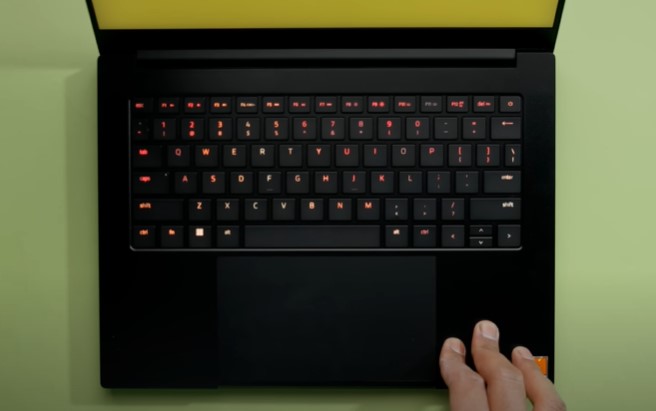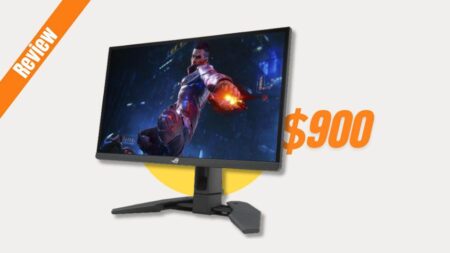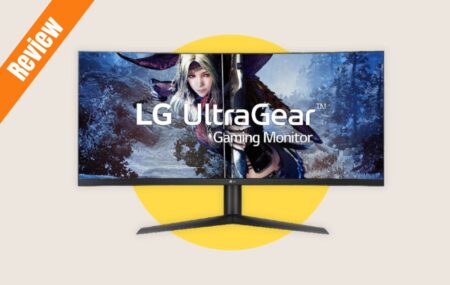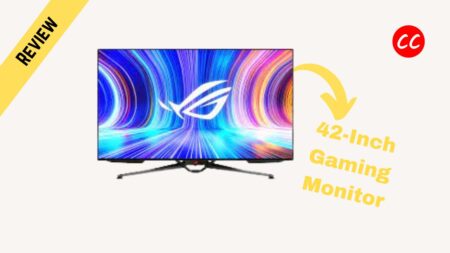Razer Blade 14 2023 marks the newest entry in Razer’s gaming laptop series. It’s notable for being their smallest and most affordable gaming laptop, joining the Blade 16 and Blade 18 models. It features AMD’s Ryzen 9 7940HS CPU and Nvidia’s RTX 4070 graphics, providing a potent mix of performance and portability.
Note: This article contains Amazon affiliate links. If you make a purchase through these links, I may earn a commission at no extra cost to you.
Design and Ports

The Razer Blade 14 2023 maintains a design similar to its predecessor, featuring a sturdy CNC-milled aluminum chassis with a boxy shape that screams durability. However, its matte black finish easily collects fingerprints, requiring some extra maintenance.
In terms of size, there have been slight adjustments compared to the previous model. It’s slightly deeper to accommodate the 16:10 display, but the length has been reduced to keep it compact. The increase in height is minimal, at just 0.04 inches, barely noticeable. Overall, the Blade 14 stands out for its solid build quality and sleek design.

In terms of ports, on the left side, you’ll find the power input, a USB Type-A 3.2 Gen 2 port, an audio jack, and a Type-C USB 4 port. This Type-C port supports Thunderbolt devices with power delivery of up to 100 watts and also functions as a display port.

On the right side, there’s a Kensington lock slot, an HDMI 2.1 port, another USB Type-A port, and a USB Type-C port. It’s important to note that unlike the Blade 16 and Blade 18 laptops, the Blade 14 doesn’t include a full-size SD card reader.
Keyboard

The Blade 14’s keyboard is a joy to use, boasting Razer’s renowned Chroma RGB lighting. Each key can be customized with various lighting effects, and they’re nicely spaced out for comfortable typing. With satisfactory key travel and tactile feedback, it’s suitable for both gaming and typing. Plus, there’s a handy column of macro keys on the left side for easy customization and quick access to commands.
As for the touchpad, it’s smooth and responsive, offering accurate tracking and support for multi-touch gestures. Thanks to Windows Precision drivers, you’ll experience precise control and seamless navigation. The physical clicks feel satisfyingly tactile and provide good feedback. Overall, the keyboard and touchpad offer a top-notch user experience.
Display
The Razer Blade 14 2023 features a 14-inch QHD display with a resolution of 2560 x 1440 pixels. This display offers excellent image quality, characterized by vibrant colors and sharp details. With a 16:10 aspect ratio, it provides a taller screen, resulting in a more immersive viewing experience. Moreover, the display boasts a 165Hz refresh rate, ensuring smooth visuals and reducing motion blur, particularly during fast-paced gaming sessions.
The thin bezels surrounding the display not only enhance the immersive feel but also maximize the screen real estate. Overall, the QHD panel on the Blade 14 gaming laptop is a standout feature, delivering impressive visuals suitable for gaming, content creation, and everyday use.
The Blade 14 comes with an integrated HD webcam positioned above the display. It serves its purpose well enough for video conferencing and casual calls, but its image quality is just average compared to dedicated external webcams. Colors might seem a bit washed out, and it doesn’t perform exceptionally well in low-light conditions. However, for occasional use, the built-in webcam on the Blade 14 does the job adequately.
Read Also: Samsung Galaxy Z FOLD 4 Review
Upgrade Options

Razer Blade 14 offers the advantage of upgradability, particularly in terms of memory. The base model includes 16GB of DDR5 memory, but users have the option to upgrade it to 32GB. This upgradeability enables better multitasking, smoother gameplay, and overall improved system performance. If you anticipate running resource-intensive applications or desire to future-proof your gaming laptop, it’s worth considering the RAM upgrade.
Battery Life
| Razer Blade 14 (2023) (68 Wh) | 10:38 |
| Razer Blade 14 (2022) (62 Wh) | 8:10 |
| Lenovo Slim Pro 9i 16″ (72 Wh) | 6:15 |
The Blade 14 is the only 14-inch laptop above in the charts. However, you have to take into account that Intel-based laptops like the Blade 16, M16, and even the ultra-portable Slim Pro 9i all have a larger battery capacity, sometimes by a significant amount. In a world where Windows 11 drains battery life faster than you can blink, achieving over 10 hours of battery life is a remarkable achievement. And while it’s slightly better than the Blade 14 from 2022, some of that improvement can be attributed to the 10% larger battery in the latest generation. Either way, if you’re looking for 14-inch portability alongside some serious performance chops, this is one of the few options available out there.
RTX 4070 Performance
When it comes to performance, comparing Razer’s marketing claims to the reality of the situation. According to Razer, the Blade 14 RTX 4070 can run up to 140 watts, but that’s not entirely accurate.
Razer suggests that the RTX 4070 can reach 140 watts, but in reality, it typically operates at a peak of 115 watts, which aligns with Nvidia’s specifications. However, there’s an additional 25 watts of potential granted by Nvidia’s Dynamic Boost algorithm.
For the RTX 4000 series to reach this maximum wattage, specific conditions need to be met, including low CPU usage and high GPU demands. If everything aligns perfectly, the GPU can detect the extra thermal power and run at a higher wattage than its base level. However, this boost only happens if the temperatures and voltage permit it. Achieving the advertised 140-watt figure mentioned by Razer demands precise conditions and a delicate balance, something unlikely to occur during regular gaming sessions.
Contrastingly, Asus provides a clearer explanation on their website. Their Dynamic Boost pack explicitly states that they utilized FurMark, a stress-testing software, to achieve their Dynamic Boost numbers.
On the other hand, Razer lacks such transparency. While the Blade 14 indeed boasts the highest-wattage RTX 4070 in a laptop of its size, there’s no need to inflate this number further. The wattage battle is important, but clarity on how this 140-watt figure was attained is crucial, especially when our observations didn’t align with it.
| Games | 1080p (Highest) Gaming | 1440p (Highest) |
|---|---|---|
| CS:GO | 68W | 82W |
| COD: Modern Warfare | 98W | 01W |
| Doom: Eternal | 108W | 115W |
| Far Cry 6 | 84W | 102W |
| Rainbow 6: Siege | 98W | 99W |
| RDR 2 | 96W | 100W |
| Star Wars: Jedi Order | 78W | 107W |
What we noticed was a significant variation in power consumption between different games when running in the highest performance mode. For instance, in CS:GO at 1080p, the power consumption was as low as 68 watts. This is because most games at this resolution are limited by the CPU, meaning the RTX 4070 isn’t fully utilized.
Conversely, in Doom Eternal at 1440p, the power consumption remained a constant 115 watts. This difference highlights a couple of things. Firstly, at 1080p, CPU limitations lead to lower power consumption. However, at 1440p, while there’s still some CPU bottlenecking, the graphics card can operate more freely, though it still falls short of Razer’s claimed 140 watts.
GPU Power, Clocks and Temperatures
| Mode | Power | Clock Speed | Temperatures | Noise level |
|---|---|---|---|---|
| Boost | 115W | 2.3 GHz | 79℃ | 54.9 dB |
| Balanced | 108W | 2.2GHz | 77℃ | 49.5 dB |
| Silent | 84W | 2.0 GHz | 74℃ | 43.5 dB |
One reason for this is that the CPU consistently operates at a minimum of 20% utilization, even within the compact chassis. Surprisingly, even with the most demanding game we tested, the smaller Blade performed admirably. The temperatures are well-controlled, maintaining high clock speeds without dropping below 84 watts. The only drawback is that in boost mode, the Blade 14’s screen can become quite loud, requiring adjustment to find a balance and protect your ears. However, reaching nearly 50 decibels isn’t too concerning, especially if you’re using headphones.
When handling a full 2D workload, the Blade 14 performs even better. Although the Intel Core i7-7940HS does tend to warm up, often reaching 75 watts, overall, its performance remains solid. It’s important to note that finding the right balance is crucial for achieving optimal performance.
Razer Blade 14 vs G14
To provide a comprehensive performance comparison, we’ve included the Blade 14 from 2022, tested in both balanced and boost modes for an accurate comparison. Additionally, we’ve added the Lenovo Slim Pro 9i to the lineup. Despite its 16-inch form factor, it’s equipped with an RTX 4070 at 100 watts and is priced similarly to the Blade 14 model. We’ve also included the Blade 16, featuring an RTX 4080, to see how stepping up in Razer’s lineup affects performance. Lastly, for a bit of fun, we’ve added the Zephyrus M16, which runs on an RTX 4090 at 88 watts but boasts the highest CPU power among the group.
Real-World Benchmarks
| Razer Blade 16 (i9-13950HX – Bal. 51W) | 2,057 |
| Lenovo Slim Pro 9i 16″ (i9-13905H – Ext. 80W) | 2,034 |
| Asus Zephyrus M15 (2023) (i9-13900H Perf. 90W) | 2,024 |
| Razer Blade 14 2023 (R9-7940H5 Boost. 75W) | 1,829 |
| Razer Blade 14 2023 (R9-7940H5 Bal,. 42W) | 1,817 |
| Razer Blade 14 2022 (R9-6900HX Boost. 72W) | 1,,574 |
| Razer Blade 16 (i9-13950HX – Bal. 51W) | 5:59 |
| Lenovo Slim Pro 9i 16″ (i9-13905H – Ext. 80W) | 5:08 |
| Asus Zephyrus M15 (2023) (i9-13900H Perf. 90W) | 4:50 |
| Razer Blade 14 2023 (R9-7940H5 Boost. 75W) | 5:28 |
| Razer Blade 14 2023 (R9-7940H5 Bal,. 42W) | 6:16 |
| Razer Blade 14 2022 (R9-6900HX Boost. 72W) | 6:40 |
| Razer Blade 16 (i9-13950HX – Bal. 51W) | 5:59 |
| Lenovo Slim Pro 9i 16″ (i9-13905H – Ext. 80W) | 5:10 |
| Asus Zephyrus M15 (2023) (i9-13900H Perf. 90W) | 5:07 |
| Razer Blade 14 2023 (R9-7940H5 Boost. 75W) | 5:27 |
| Razer Blade 14 2023 (R9-7940H5 Bal,. 42W) | 5:36 |
| Razer Blade 14 2022 (R9-6900HX Boost. 72W) | 6:22 |
In the benchmarks above, you’ll notice that the 7940HS is highly competitive with some of the fastest Intel laptop CPUs currently available, particularly when operating at similar power levels. This represents a significant performance leap compared to the 6900HS found in last year’s Blade 14. Upon closer examination, you’ll see that the 7940HS running at just 42 watts can outperform a 6900HS running at 30 watts or even higher in terms of performance per watt, which is crucial in the laptop market. AMD has achieved something remarkable with the same 8-core, 16-thread layout.
| Razer Blade 16 (i9-13950HX – Bal. 51W) | 3:05 |
| Lenovo Slim Pro 9i 16″ (i9-13905H – Ext. 80W) | 3:59 |
| Asus Zephyrus M15 (2023) (i9-13900H Perf. 90W) | 3:19 |
| Razer Blade 14 2023 (R9-7940H5 Boost. 75W) | 3:42 |
| Razer Blade 14 2023 (R9-7940H5 Bal,. 42W) | 3:43 |
| Razer Blade 14 2022 (R9-6900HX Boost. 72W) | 3:58 |
When it comes to DaVinci Resolve, its RTX 4070 performs remarkably well. It’s only 23 seconds behind the RTX 4090 in the Zephyrus M16, and it outshines the Pro 9i by a significant margin. However, Adobe Premiere presents a challenge for AMD-based laptops. Intel CPUs with Quick Sync acceleration typically have an edge due to parallel rendering, even when equipped with identical graphics cards. Moreover, there’s a known issue in Premiere affecting the performance of AMD CPUs in this test, and we’re hopeful for a resolution soon.
Gaming Performance
| Razer Blade 16 (RTX 4080 – bal. 120W)) | 83.2 – 120.6 |
| Lenovo Slim Pro 9i 16″ (RTX 4070 – Ext. 100W)) | 67.4 – 120.6 |
| Asus Zephyrus M15 (2023) (RTX 4090 – Bal. 88W)) | 89.1 – 124.1 |
| Razer Blade 14 2023 (RTX 4070 – Boost. 115W)) | 67.1 – 98. 5 |
| Razer Blade 14 2023 (RTX 4070 – Bal. 108W) | 61.2 – 95.8 |
| Razer Blade 14 2022 (RTX 3070 Ti – Boost. 100W) | 56.4 – 86.0 |
Gaming performance, particularly at 1080p resolution across various titles, it offers decent gaming performance, but there are still some consistency issues with the RTX 4070, especially noticeable in games like CS:GO and in the one percent lows in Doom and a few others. This inconsistency has also been observed on the desktop side, so it’s somewhat expected here.
It’s frustrating that these issues persist even after the launch of the RTX 4000 series. The lack of consistency is a significant aspect of the Blade 14’s performance. There are moments when it outperforms the 2022 version, but other times, it struggles to deliver noticeably better frame rates.
The success of a gaming laptop largely hinges on its GPU, and unfortunately, the RTX 4070 doesn’t offer a significant improvement over the 3070 Ti. Even considering some CPU bottlenecking, at 1440p resolution, it requires more power to achieve only a slight improvement.
As a result, the Blade 14 is only marginally faster than its predecessor from a year ago. While there are instances where there’s a noticeable performance boost, and the AMD CPU occasionally encounters difficulties, this might raise concerns for individuals considering investing $2,700 in a gaming laptop.
It’s understandable why Nvidia is promoting DLSS3, as without it, the 4070 feels like a lackluster addition to a gaming laptop that is ultimately pricier than last year’s model. It’s almost as if they’re suggesting, “If you truly want an upgrade, consider the 4080.
Conclusion
The Razer Blade 14 consistency is the crucial factor to consider. On one hand, it offers one of the best-designed ultra-portable gaming laptops, featuring a stunning display, upgradable memory, a highly capable Ryzen CPU, and impressive battery life—a remarkable feat in 2023.
However, there’s a significant downside. Even when operating at maximum wattage, the RTX 4070 doesn’t deliver a substantial upgrade over last year’s Blade 14. While it still provides impressive frame rates for a thin and light 14-inch laptop, many, including myself, expected more from it. With that said, I hope you’ve gained all the necessary information about the Razer Blade 14 (2023).
The Razer Blade 14 is a formidable gaming laptop that offers a powerful combination of hardware, portability, and aesthetics. With its compact design, high-quality display, and top-notch performance, it's an excellent choice for gamers, content creators, and professionals on the go.
-
Design10
-
Ports9
-
Display9
-
Keyboard and trackpad9
-
Upgradeability7.5
-
Battery Life9
-
Performance9




